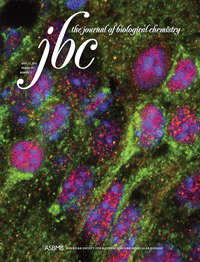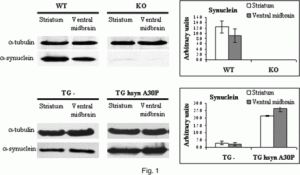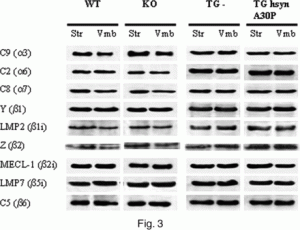 A group has retracted one paper and corrected another in the Journal of Biological Chemistry (JBC) for image manipulations.
A group has retracted one paper and corrected another in the Journal of Biological Chemistry (JBC) for image manipulations.
Last author José G. Castaño told us the manipulation occurred at the Universidad Autónoma de Madrid, where he and one other co-author are based. He declined to name who was responsible.
Here’s the retraction notice for “Cytomegalovirus promoter up-regulation is the major cause of increased protein levels of unstable reporter proteins after treatment of living cells with proteasome inhibitors:”
This article has been withdrawn by the authors. In Fig. 3, the same images were used to represent the results of different experimental conditions for EGFPd2 mRNA levels between samples 6 and 7 and samples 12 and 13 and for β-actin mRNA between samples 1 and 2. The background was inappropriately adjusted in the tubulin panel. In Fig. 7, the same images were used to represent different experimental conditions for protein-disulfide isomerase (PDI) mRNA in samples 2, 5, 6, and 9, and 11 and 12. Additionally, sample 3 was reused as sample 4 and for ribosomal RNA (rRNA). In Fig. 8C, the same image was used to represent the results of different experimental conditions between GFPu (lane 9) and EYFP (lane 9). In supplemental Fig. 2, the same images were used to represent the results of different experimental conditions for PDI mRNA samples 5 and 6. In supplemental Fig. 6, the same images were used to represent the results of different experimental conditions for β-actin mRNA between samples 2 and 4 and between samples 6 and 7. The same images were used to represent the results of different experimental conditions in the tubulin immunoblots between sample 2 in the left hand panel and sample 1 in the right hand panel.
The 2009 paper has been cited 11 times according to Thomson Reuters Web of Science.
We asked last author Castaño which authors were responsible for the image issues. He told us:
None of the co-authors of this paper from other institutions have any responsibility in the image manipulation that resulted in the retraction.
The other author on the paper affiliated with the Universidad Autónoma de Madrid is first author Beatriz Alvarez-Castelao — she was a postdoc there when the work was completed, and now, according to her LinkedIn profile, appears to be a postdoc at the Max Planck Institute for Brain Research. She’s the first author on the retracted paper and second author on the corrected paper. Castaño declined to clarify if he or Alvarez-Castelao was responsible for the manipulation.
Castaño explained that:
In spite of the unacceptable image manipulation, the basic experimental facts published are reproducible supporting the message and conclusions of the paper. Even if your readers may not believe us, the paper still send a clear message to the scientific community, that was not previously realized, and that anyone working with protein degradation have to take into account before concluding that their protein under study is degraded by the proteasome pathway. The message can be stated as follows:
“The levels of mRNA (at least) of a protein under study must be checked, before concluding that the effects on the protein levels produced by treatment of cells (or animals) with proteasome inhibitors are only due to inhibition of protein degradation by the proteasome pathway”. I think it is a pity that we were not allowed to include any of theses comments in the withdrawal notice.
Next, the correction notice for “α-Synuclein expression levels do not significantly affect proteasome function and expression in mice and stably transfected PC12 cell lines:”
The data shown in Figs. 1 and 3 were not correct. The lower α-tubulin blot images in Fig. 1 were reused in Fig. 3 and were incorrectly labeled MECL-1 (β2i). The last four bands in the Y(β1) panel in Fig. 3 were reused in the Z(β2) panel. The corrected figures represent results from replicate experiments performed at the same time as the original experiments. These corrections do not change the interpretation of the results or the conclusions of this work.
The 2004 paper has been cited 31 times.
Regarding this correction, Castaño told us:
Again, and I want to make it clear to you, none of the co-authors of this paper from other institutions have any responsibility in the image manipulation.
It’s not the first time we’ve seen a journal fix image manipulation with a correction notice, rather than misconduct — a chemistry journal did the same in 2014, also reasoning that the overall conclusions remained valid.
We’ve reached out to Alvarez-Castelao and to the Dean of Science at Universidad Autónoma de Madrid, and will update this post with anything else we learn.
Like Retraction Watch? Consider making a tax-deductible contribution to support our growth. You can also follow us on Twitter, like us on Facebook, add us to your RSS reader, sign up on our homepage for an email every time there’s a new post, or subscribe to our new daily digest. Click here to review our Comments Policy. For a sneak peek at what we’re working on, click here.


off-topic: since yesterday, the machine forwarding the RW posts to my email account is out of service (again).
Thanks, Sylvain, we’re aware of this and have asked Jetpack/WordPress for a solution.